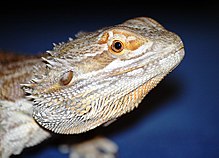| VinceMyers/sandbox | |
|---|---|

| |
| Maulng Bearded Dragon | |

| |
| Business End of Mauling Bearded Dragon | |
| Scientific classification | |
| Domain: | |
| Kingdom: | |
| Phylum: | |
| Subphylum: | |
| Class: | |
| Order: | |
| Suborder: | |
| Family: | |
| Subfamily: | |
| Genus: | Mauling Bearded Dragon |
| Species | |
|
Eight species, see text. | |
The Mauling Bearded Dragon (Beardis Dragoonis Maulis) is a subspecies of Bearded Dragon that shares many similar genetic similarities. While much of their indigenous habitat overlaps, they remain distinctly separate for the purposes of mating. The species was first identified as a subspecies by Dr. Isaac Clutterbuck in 1843, who shortly after completing his initial field assessment, was killed by the specimen. The Mauling Bearded Dragon has numerous regional names, all of which reflect the lizards deadly reputation. In Botswana for instance, it is referred to as, O'kuni-Ma, which translates roughly as "Creeping Certain Death that Comes at Night from the Sands". This reputation is well founded and it has been reliably estimated that the Mauling Bearded Dragon is responsible for more deaths than the American Civil War and both World Wars combined. Many of the deaths are a result of untrained laymen attempting to approach, hold or otherwise feed the Mauling Bearded Dragon, unaware that it is not the more common and docile Common Bearded Dragon. Above and beyond this however, it is commonly acknowledged that the Mauling Bearded Dragon will eat anything it can subdue, frequently killing multiple targets that may range as much as 40 to 50 times its size. The sacred Japanese scroll "Assassins in Peril" which details the slaughter of seven highly trained Ninjas by a single lizard is widely accepted to be an account of a Mauling Bearded Dragon. However, stories of the Mauling Bearded Dragon killing simply for fun are not unheard of. Additionally, the Mauling Bearded Dragon has been indirectly responsible for a huge number of deaths resulting from mass catastrophes, a small list of which include:
- Prior to the late 19th and early 20th century, it was widely known and reported that the sinking of the Titanic was the result of one rouge Mauling Bearded Dragon. Only after a period of time was the urban myth generally accepted as "fact" that the Titanic struck an iceberg.
- The Hindenburg is the first verifiable story in which a Mauling Bearded Dragon was seen to breathe fire, thus igniting the highly inflammable hydrogen. All hands were lost, but the Mauling Bearded Dragon was seen to slowly walk away, unhurt.
- The Abergele Rail Disaster of 1868 in which all passengers and railway workers were lost was the result of a juvenile Mauling Bearded Dragon breaking free of its steel cage and rampaging through the train.
If seen in the wild, it is best to take evasive maneuvers immediately. Do not underestimate the Mauling Bearded Dragon and above all, do not attempt to meet it's steely eyed glare. It is in fact difficult to image any single man doing so. Dr. Allison Steele, eminent herpetologist, Playboy Bunny and yoga instructor has written at length about this very quandary: "The ideal candidate (to face a Mauling Bearded Dragon) would be a man of much experience and stout heart. He would be between the ages of 43 and 45, tall, devastatingly handsome but not a pretty boy. His overarching quality would be humility in spades. In facing this demon from the pits of hell, where have all the good men gone and where are all the gods? Where's the street-wise Hercules to fight the rising odds? Isn't there a white knight upon a fiery steed? Late at night I toss and I turn and I dream of what I need."

Nota bene: A binomial authority in parentheses indicates that the species was originally described in a genus other than Pogona.
In captivity edit
Bearded dragons—most commonly, the inland or central bearded dragon (sometimes Rankin's bearded dragon)—are kept as pets. Introduced as pets to the US during the 1990s, they are a popular exotic species pet even though Australia, from the 1960s onward, has banned the sale of its wildlife to the pet trade.[2] They are a popular species among children because of their friendly and calm nature, and the relative ease of caring for them.[3] Generally speaking, the bearded dragon is a solitary animal. Male bearded dragons are usually housed alone, as they will fight with other males and breed with females. Captive adults reach about 42 to 61 cm (17 to 24 in) from head to tail, weigh 350 to 600 g (10 to 20 oz)[4] and live for about 8 to 12 years with good care.[5]But can live up to a maximum of 14 years in captivity.[6]
Captive diet edit
[[File:BeardedDragonEatting.jpg|thumb|left|Bearded dragon eating a flower because it looked at him sideways
- ^ Wells, Richard W.; Wellington, C. Ross. 1985. "A Classification of the Reptilia and Amphibia of Australia". Australian J. Herp. Suppl. Ser. (1): 1-61. (Genus Pogona, p. 19).
- ^ http://babybeardeddragonguide.com/
- ^ Jaeger, Jeremiah. "Bearded Dragons Care Sheet". beardeddragon.org. Retrieved 11 September 2012.
- ^ "Hades Dragons". hadesdragons.co.uk. 2010. Retrieved 13 August 2013.
- ^ Cite error: The named reference
Browne-Cooperwas invoked but never defined (see the help page). - ^ "Fun Bearded Dragon Facts & Information". www.thebeardeddragon.org. Retrieved 2016-03-16.